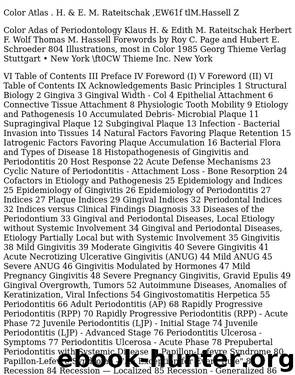0865772142 by Unknown

Author:Unknown
Language: eng
Format: epub
Initial Therapy 153 Before jL'^PHk 388 Moderate periodontitis - Diastema caused by the drifting of teeth The patient reported that the 3 mm space between his front teeth had developed over the course of the previous 2 years. Drifting of the maxillary anterior teeth could be due to the severe gingival inflammation and the localized deep periodontal pockets, as well as functional forces from premature contacts, overbite and a shift during intercuspation. Tooth migration during periodontitis After 389 Findings 9 years after initial therapy The only treatment provided for this patient was initial therapy, occlusal equilibration and slight shortening of tooth 21. The gingival inflammation remained under control despite the patient's less than optimum motivation and cooperation with home care. The diastema closed spontaneously six month after initial therapy, without any orthodontic measures. Tooth 23 became dark after endodontic treatment for pulpitis. Before Advanced periodontitis After 390 Advanced periodontitis (RPP) Pronounced marginal inflammation, hemorrhage at the lightest touch (PBI 4), 10 mm pockets with suppuration. The margins of posterior full crowns are at least 2 mm apical to the gingival margin. 391 Findings 3 months after initial therapy Inflammation is absent for the most part. Gingival tone has returned after tissue shrinkage that resulted in irregular contour. Crown margins are now supragin- gival. Some deep pockets (crater- ing) persist, some with signs of active disease. Re-evaluation of this case clearly demonstrates that without surgical intervention the deep active pockets cannot be expected to disappear.
154 Therapy 392 Acute stage of Gingivoperiodontitis ulcerosa The gingivae are severely inflamed (PBI 3-4) and exhibit pronounced ulcerations in the interdental areas. Gingival contour is "inverted" (reverse architecture) as a result of attachment loss associated with osseous interdental cratering. Probing depths are relatively shallow (4—5 mm) due to loss of interdental papillae. 393 Findings 6 months after initial therapy The acute phase was completely eliminated by initial therapy. A surgical procedure is nonetheless required in the mandibular anterior region in order to create a morphological situation that the patient can keep clean. Frequent recall will be necessary thereafter if the results achieved are to be maintained. Before Gingivoperiodontitis ulcerosa (ANUG) After 394 Stillman's cleft with secondary inflammation Calculus is visible in the gingival cleft on tooth 21. Use of erythrosin disclosing solution also revealed a small accumulation of microbial plaque. This patient practiced oral hygiene vigorously but incorrectly, using a horizontal scrubbing technique with a hard-bristled toothbrush. Thus, the etiology of the Stillman's cleft could involve both plaque-elicited inflammation and trauma from toothbrushing. 395 Findings 3 months after initial therapy The Stillman's cleft closed spontaneously solely as a result of repeated careful scaling of the root surface in the area of the cleft, and "freshening up" of the edges of the soft tissue. The patient's brushing technique was changed to modified Stillman (vertical rotatory). Sulcus depth at the location of the former cleft is completely normal! Before Recession - Cleft After
Periodontal Surgery 155 Periodontal Surgery Periodontal surgical therapy is only a part of complete periodontal treatment. If surgery is necessary at all, it is usually perfomied as part of a second phase of therapy.
Download
This site does not store any files on its server. We only index and link to content provided by other sites. Please contact the content providers to delete copyright contents if any and email us, we'll remove relevant links or contents immediately.
Tools of Titans by Timothy Ferriss(7805)
Crystal Healing for Women by Mariah K. Lyons(7709)
The Witchcraft of Salem Village by Shirley Jackson(7030)
Inner Engineering: A Yogi's Guide to Joy by Sadhguru(6438)
The Four Agreements by Don Miguel Ruiz(6310)
The Power of Now: A Guide to Spiritual Enlightenment by Eckhart Tolle(5329)
Secrets of Antigravity Propulsion: Tesla, UFOs, and Classified Aerospace Technology by Ph.D. Paul A. Laviolette(4974)
The Wisdom of Sundays by Oprah Winfrey(4946)
Room 212 by Kate Stewart(4731)
Pale Blue Dot by Carl Sagan(4613)
Fear by Osho(4491)
The David Icke Guide to the Global Conspiracy (and how to end it) by David Icke(4376)
Rising Strong by Brene Brown(4190)
Animal Frequency by Melissa Alvarez(4148)
How to Change Your Mind by Michael Pollan(4112)
Sigil Witchery by Laura Tempest Zakroff(4027)
Real Magic by Dean Radin PhD(3920)
The Art of Happiness by The Dalai Lama(3844)
Man and His Symbols by Carl Gustav Jung(3843)
